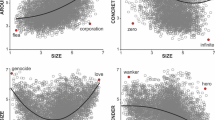Abstract
Two experiments examined whether syntactic number features are tracked during comprehension with a linear slot-based memory system or with a hierarchical feature-passing system. In a construction such as The pond near the trail(s) for the horse(s) was ¨, a linear account of subject-number tracking predicts greater interference from horses (N3), whereas a hierarchical account predicts greater interference from trails (N2). Experiment 1 used singular-head subject noun phrases (e.g., pond) and showed equal interference from N2 and N3, failing to differentiate between linear and hierarchical accounts. Experiment 2 used plural-head subjects and revealed more interference from N2 than N3. The pattern across the experiments accords with the ideas that (1) feature-tracking is hierarchical (e.g., Vigliocco & Nicol, 1997), (2) plurals are marked (e.g., Eberhard, 1997), and (3) subject-number information decays across intervening number-marked elements.
Similar content being viewed by others
REFERENCES
Bock, K., & Cutting, J. C. (1992). Regulating mental energy: Performance units in language production. Journal of Memory and Language, 31, 99–127.
Bock, K., & Eberhard, K. M. (1993). Meaning, sound and syntax in English number agreement. Language and Cognitive Processes, 8, 57–99.
Bock, K., & Miller, C. A. (1991). Broken agreement. Cognitive Psychology, 23, 45–93.
Bock, K., Nicol, J. L., & Cutting, J. C. (1999). The ties that bind: Creating number agreement in speech. Journal of Memory and Language, 40, 330–346.
Eberhard, K. M. (1997). The marked effect of number on subject-verb agreement. Journal of Memory and Language, 36, 147–164.
Ferreira, F., & Clifton, C., Jr. (1986). The independence of syntactic processing. Journal of Memory and Language, 25, 348–368.
Gibson, E., Pearlmutter, N. J., Canseco-Gonzalez, E., & Hickok, G. (1996). Recency preference in the human sentence processing mechanism. Cognition, 59, 23–59.
Just, M. A., Carpenter, P. A., & Woolley, J. D. (1982). Paradigms and processes in reading comprehension. Journal of Experimental Psychology: General, 111, 228–238.
Kay, M. (1985/1986). Parsing in functional unification grammar. In B. Grosz, K. S. Jones, & B. L. Webber (Eds.), Readings in natural language processing (pp. 125–138). Los Altos, CA: Morgan Kaufmann. [Reprinted from D. R. Dowty, L. Kartunnen, & A. Zwicky (Eds.), Natural language parsing (pp. 251–278), Cambridge, UK: Cambridge Univ. Press.]
Nicol, J. L., Forster, K. I., & Veres, C. (1997). Subject–verb agreement processes in comprehension. Journal of Memory and Language, 36, 569–587.
Pearlmutter, N. J., Garnsey, S. M., & Bock, K. (1999). Agreement processes in sentence comprehension. Journal of Memory and Language, 41, 427–456.
Stevenson, S. (1994). A competitive attachment model for resolving syntactic ambiguities in natural language parsing (Tech. Rept. RuCCS TR-18). New Brunswick, NJ: Rutgers Univ., Center for Cognitive Science.
Vigliocco, G., & Nicol, J. (1997). The role of syntactic tree structure in the construction of subject-verb agreement. Unpublished manuscript.
Vigliocco, G., & Nicol, J. (1998). Separating hierarchical relations and word order in language production: Is proximity concord syntactic or linear? Cognition, 68, B13–B29.
Author information
Authors and Affiliations
Rights and permissions
About this article
Cite this article
Pearlmutter, N.J. Linear versus Hierarchical Agreement Feature Processing in Comprehension. J Psycholinguist Res 29, 89–98 (2000). https://doi.org/10.1023/A:1005128624716
Issue Date:
DOI: https://doi.org/10.1023/A:1005128624716




